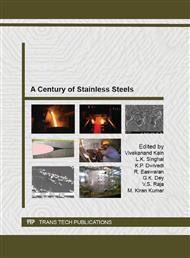p.468
p.476
p.484
p.493
p.502
p.507
p.517
p.530
p.539
Influence of Copper on Redistribution Behaviour of Boron in Titanium Stabilized and Low Carbon Steel as Observed by Neutron Induced Alpha Autoradiography
Abstract:
Boron content and its distribution play a significant role in modifying the metallurgical and mechanical properties of many steels and alloy at lower level of concentration. Precipitation of boron at the grain boundaries, have shown to improve the creep strength in titanium stabilized steel, high temperature ductility in low carbon corrosion resistant steel and the hardenability in low carbon steel in general. Titanium-stabilized steel (DIN 1.4970), was developed as a possible material for fast breeder sodium-cooled nuclear reactor core components for its superior creep strength, high micro-structural stability and elevated void swelling resistance. It is well known that, helium produced during neutron irradiation through the 10B(n,α)Li7 reaction, affects the mechanical properties and the amount of void swelling in nuclear reactor materials. Two nos. of Ti-stabilized steel samples with 40ppm boron and 2ppm boron (DIN 1.4970 & DIN1.4970LB steel) were analyzed for boron re-distribution behavior during different thermo-mechanical treatment using a technique known as Neutron Induced Alpha Autoradiography (NIAA). This technique is a well known technique, and widely used for revealing the spatial distribution of boron in the materials with a resolution approaching to ppm level. This technique has also been used to detect the influence of copper addition on boron distribution pattern in steel specimen. Mapping of boron autoradiography of Low carbon steels containing 20ppm of boron with and without copper was able to demonstrate this behavior. Boron track mapping of Low carbon steel without copper, in solution annealing treatment, show the uniform distribution of boron throughout the matrix, whereas when the similar steel with 1.48% copper was mapped, it shows the precipitation of boron at the grain boundaries.
Info:
Periodical:
Pages:
502-506
Citation:
Online since:
September 2013
Authors:
Price:
Сopyright:
© 2013 Trans Tech Publications Ltd. All Rights Reserved
Share:
Citation:


